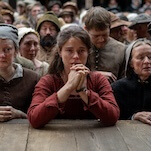Like a lot of artistic movements, the Dogme 95 manifesto cooked up by Lars von Trier and three other Danish filmmakers was both silly and ingenious. On the one hand, many of the rules outlined in its “vow of chastity”—no outside props, no director credit, no “superficial action”—seem fairly arbitrary; it’s hard to believe that more than 250 films slavishly conforming to them have been produced to date. (The vast majority are little-known films, most likely with good reason. Also, I’m curious about rule No. 9, which demands filmmakers shoot on 35mm. Have they caved on that?) On the other hand, Dogme 95 fully achieved its true goal, which was to force von Trier in particular to radically reinvent himself. Abandoning the chilly formalist style of Zentropa and The Element Of Crime in favor of emotionally direct handheld chaos, he achieved breakout success with 1996’s Breaking The Waves (not technically a Dogme film, but certainly influenced by the concept). And ever since, he’s imposed certain “obstructions” upon himself to stimulate new ways of thinking.
With 2000’s Dancer In The Dark, von Trier decided to make a musical. He commissioned Björk to write the music and cast her as the protagonist, Selma, a mousy factory worker who spends her evenings in a community-theater production of The Sound Of Music, and imagines her own life as a musical whenever she’s bored, anxious, or horribly traumatized. This isn’t a Dogme film, either (The Idiots is the only one von Trier ever made), but it nonetheless represented a daunting formal challenge. And the result raises a fascinating question: Can a musical be great even if its musical numbers don’t work? Selma’s elaborate fantasies don’t function as conventional showstoppers, but that’s clearly intentional. The problem is that they don’t seem to function at all, except to remind viewers that they’re watching a musical. Von Trier rejects tradition without finding anything coherent to replace it with. Take a look at arguably the film’s best number, “I’ve Seen It All,” and watch two very talented artists flail.
At the time Dancer In The Dark was released, a great deal was made of the fact that von Trier used 100 DV cameras to shoot the film’s major musical sequences, including this one. To some extent, that was probably press-kit hype; maybe they had 100 cameras on hand, but if all of them were in operation here, then at least half of them apparently caught nothing usable. (The rapid cutting throughout, combined with the train’s constant movement, makes it tough to count potential cameras, but there are only about 130 shots in the entire number as edited, and a lot of those are clearly repeats.) The idea, I gather, was that rather than repeat their actions for multiple setups, Björk, Peter Stormare, and the dancers could perform the routine in real time—albeit still probably more than once, film shoots being what they are—with however many cameras capturing everything from a multitude of angles simultaneously. It’s somewhat Dogme-esque, in that it imposes a measure of physical authenticity onto something artificial.
This approach obviously saves a lot of time, but I’m not sure that it boasts many other advantages. There’s a certain pleasure in seeing so many match cuts in such an unusual context—consecutive shots were often clearly filmed at precisely the same time, and that tends to trigger an unconscious sense of “reality,” even more so than lengthy, unbroken takes. Then again, the whole point of Dancer’s musical numbers is that they’re entirely in Selma’s head—a conceit only undermined by unconscious realism. More damagingly, these shots just don’t cohere. Nothing is gained by seeing Selma board the train from five different angles in rapid succession; it’s a technique that just calls attention to itself. And it can’t be rationalized as the character’s naïve conception of what a musical would look like, because she’s a nut for Hollywood musicals (we see her watching them in movie theaters twice, with her best pal, Catherine Deneuve), and no Hollywood musical has ever looked anything even remotely like this.
By the same token, it’s not at all clear whether Von Trier was deliberately trying to make the dancing look amateurish because these are Selma’s fantasies and she’s just a factory worker, or whether he simply had no idea what the hell he was doing. It could conceivably be a combination of both. The problem is that the routines are neither impressive nor charmingly unimpressive. (For an example of the latter, see Woody Allen’s Everyone Says I Love You.) They’re an embodiment of “the idea of routines,” in the same way that the chalk outlines in Dogville are the embodiment of “the idea of a set.” Try as I might, I can’t work out an intelligible rationale for that in this particular movie. We would have to be seeing… I honestly don’t know. The awkward reality of Selma’s imagined numbers if they were actually occurring? I’m mostly wincing throughout, but I can’t fathom why I ought to be wincing. (That’s in distinct opposition to the rest of the film, by the way, which provokes wincing and cringing that’s fully comprehensible.)
It’s a pity, because “I’ve Seen It All” is a lovely tune, with a plaintive melody and poignant lyrics about Selma’s acceptance of her impending blindness. (“You’ve never been to Niagara Falls” / “I have seen water; it’s water, that’s all” is a conversation I’ve actually had.) It works like gangbusters on Selmasongs, Björk’s sort-of soundtrack album, on which she duets with Radiohead’s Thom Yorke rather than Stormare. But it stops Dancer In The Dark cold, and with the exception of a solo rendition of “My Favorite Things,” so do all the other musical numbers. The film works anyway—I’ve seen it three times, and never made it to the end with dry eyes—and that’s a testament to how potent the immediacy of the Dogme 95 style can be, even when it isn’t practiced to the letter. (It’s also a testament to Björk’s bravura performance, which would be one of the most noteworthy of the ’00s even if she’d never sung a note.) But can a musical be great even if the musical numbers don’t work, allowing for all possible definitions of what constitutes “working”? Judging from this wildly offbeat attempt, and with no counterexamples springing to mind, I’d say: Almost.








































